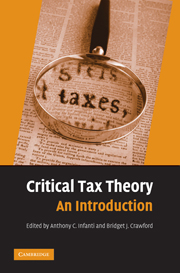Book contents
- Frontmatter
- Contents
- List of Illustrations
- List of Tables
- List of Contributors
- List of Common Abbreviations
- Introduction
- CHAPTER 1 FOUNDATIONS OF CRITICAL TAX THEORY
- Sexism in the Code: A Comparative Study of Income Taxation of Working Wives and Mothers
- CHAPTER 2 HISTORICAL PERSPECTIVES ON TAXATION
- CHAPTER 3 THE GOALS OF TAX POLICY
- CHAPTER 4 CRITICAL TAX THEORY MEETS PRACTICE
- CHAPTER 5 RACE AND TAXATION
- CHAPTER 6 GENDER AND TAXATION
- CHAPTER 7 SEXUAL ORIENTATION AND TAXATION
- CHAPTER 8 THE FAMILY AND TAXATION
- CHAPTER 9 CLASS AND TAXATION
- CHAPTER 10 DISABILITY AND TAXATION
- CHAPTER 11 GLOBAL CRITICAL PERSPECTIVES ON TAXATION
- CHAPTER 12 CRITICAL PERSPECTIVES ON CRITICAL TAX THEORY
- Index
Sexism in the Code: A Comparative Study of Income Taxation of Working Wives and Mothers
Published online by Cambridge University Press: 04 August 2010
- Frontmatter
- Contents
- List of Illustrations
- List of Tables
- List of Contributors
- List of Common Abbreviations
- Introduction
- CHAPTER 1 FOUNDATIONS OF CRITICAL TAX THEORY
- Sexism in the Code: A Comparative Study of Income Taxation of Working Wives and Mothers
- CHAPTER 2 HISTORICAL PERSPECTIVES ON TAXATION
- CHAPTER 3 THE GOALS OF TAX POLICY
- CHAPTER 4 CRITICAL TAX THEORY MEETS PRACTICE
- CHAPTER 5 RACE AND TAXATION
- CHAPTER 6 GENDER AND TAXATION
- CHAPTER 7 SEXUAL ORIENTATION AND TAXATION
- CHAPTER 8 THE FAMILY AND TAXATION
- CHAPTER 9 CLASS AND TAXATION
- CHAPTER 10 DISABILITY AND TAXATION
- CHAPTER 11 GLOBAL CRITICAL PERSPECTIVES ON TAXATION
- CHAPTER 12 CRITICAL PERSPECTIVES ON CRITICAL TAX THEORY
- Index
Summary
Close scrutiny of the Code reveals a strong pattern of work disincentive for married women and inequitable treatment of the two-earner family. The observation that American working wives are predominantly secondary family earners is not intended to express a social ideal. It merely reflects a contemporary social reality. Women workers generally earn substantially less than their male counterparts. Working wives earn less than their employed husbands. The American wife's working career is likely to be broken by child bearing and -rearing. Unless prompted by economic necessity, her return to work is generally considered discretionary. Even when she is earning a substantial salary, her husband is unlikely to view his employment as discretionary. Thus, the American working wife should properly be understood as a secondary family earner for the purpose of determining the work disincentive effect of various Code provisions.
UNITED STATES TAXATION OF WORKING WIVES AND MOTHERS
Prior to 1948, taxation was individual. Joint returns were authorized but seldom used because the aggregate family income was taxed as though it were the income of a single taxpayer. Since each individual taxpayer was taxed at progressive rates, a tax benefit would result from shifting earned and unearned income among family members. (Earned income is the fruit of personal effort and labor, e.g., salary; unearned income arises from the ownership of property, e.g., rent and dividends.) Thus, a husband with taxable earned income of $8,000 would secure a tax advantage by shifting $4,000 to his wife. Because of the progressive nature of income tax rates, each would pay less than one-half of the tax that the husband would have paid on the entire amount.
- Type
- Chapter
- Information
- Critical Tax TheoryAn Introduction, pp. 3 - 10Publisher: Cambridge University PressPrint publication year: 2009
- 4
- Cited by



